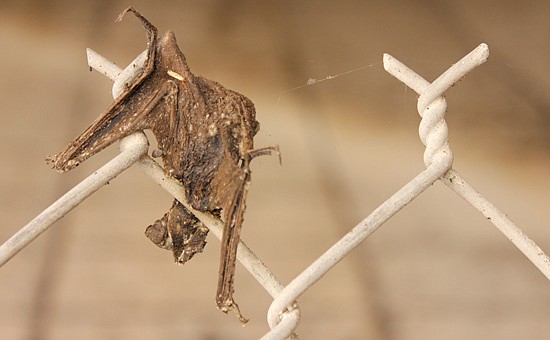- July 26, 2024
-
-
Loading

Loading

You can smell them before you see them. A slight northerly shift of the wind, and a stench neighbors can only describe as ammonia-laced old urine makes breathing in through your nose outside of 82-year-old Maitland resident Willie Bell Gibbons’ front porch nearly unbearable.
A few footsteps past where the gravel road of Amado Lane ends and newly paved Mechanic Street begins, and you can start to hear their sound. A screeching symphony thousands of voices strong sings from the cracks of the Maitland Boulevard overpass.
At midday, the masses remain tucked intently out of sight – except for a handful of colony members now silent, their fist-sized bodies now crusting over lying dead in the grass. One mangled winged body didn’t make it that far, meeting its end hanging from the twisted metal top of a bordering chain-link fence.
It’s a fate Gibbons, her family and neighbors hopelessly wish all the thousands of bats taking residence under the bridge would meet.
“You can’t even sit outside, it’s terrible,” Gibbons’ daughter Katrina Jones said. “Sometimes you can’t even walk over there to get your mail it smells so bad.”
Mailboxes for the few houses still standing in the predominantly African-American Maitland neighborhood off of Mechanic Street sit under the bridge. Two-inches of dark brown bat feces – known as guano – settles in a think layer on top of the boxes.
“You get your mail, and you know it’s in your mail. And it’s on the ground and now it’s on your shoes, and now you’re taking it into your house,” Jones said.
In her home next door, Martha Bryant-Hall says the bats are making themselves even more comfortable. Months ago, she stopped entering her house at night through the garage after she found bats hanging out in there after dark. Then earlier this month, a roofer found more making a home out of the eaves of her front porch, leaving bats standing between her and both entrances.
“Enough is enough, and when the bats decide they’re coming to live with me, that’s enough,” Bryant-Hall said.
She dug out the familiar phone numbers she’s been dialing for decades hoping for help, and asked city officials and the Florida Department of Transportation, which maintains the bridge, to take action and do something about the bats.
But Maitland Public Works director Rick Lemke said by Florida state law, killing the bats is illegal. Forcing them out is an in-depth process. And keeping them out of a structure as large and crevassed as the underside of the overpass is nearly impossible.
“It is a problem, it’s frustrating for us as well, but it’s state law,” Lemke said.
FDOT spokesman Steve Olson said the department maintains many bridges that bats call home, but none as close to nearby neighborhoods as where Maitland Boulevard crosses over Mechanic Street. In other areas, Olson said people actually praise the bats for ridding places of mosquitoes and other insects.
But, he said, “Those people who are telling us of the benefits probably aren’t living directly downwind.”
FDOT Maintenance Engineer Mike Danos said the department realizes these bats are “a little too close and a lot too many.” He said FDOT is scheduled to send crews to pressure wash the bridge to rid it of guano buildup this week.
Washing the bridge and spraying the ground with fungicide, Olson said, has been the department’s best plan of action to clean up after the bats. But, at Mechanic Street, it’s been more than a year since the last washing.
“We haven’t been able to get in there and clean as much as we wanted, or probably should,” Olson said.
With SunRail workers preparing the tracks under the bridge for the past six months readying for the commuter rail’s launch, he said it’s prohibited FDOT from getting under it to clean. He said the additional activity also could be the reason why the bats have sought shelter in Bryant-Hall’s house.
Bryant-Hall said during the months the workers were there, they’d wear masks to alleviate the smell, and ask her how she could stand living there breathing it in everyday.
She didn’t have an answer, adding that the nighttime intruders are only one of many nuisances she’s taken issue with in her neighborhood since moving in more than 30 years ago. A decade after Maitland annexed the area, she said she’s still fighting the same battles for basic equality of services as she was decades ago.
“What I’m experiencing in my neighborhood isn’t what you’re getting in yours,” she said. “… Maitland is still a city of the ‘haves’ and ‘have-nots.’”
“If it was happening in [city officials’] backyards, it’d be fixed in two weeks … we’ve been dealing with it here for years,” Jones added.
Lemke said no matter where the bats call home in Maitland, the same issues and laws are in place for relocating them. He said a bat house was installed in 2000 at Community Park to give bats an alternative place to live, but that there’s been little to no evidence that bats have decided to use it. But, he said, there are currently no other areas in the city dealing with an influx colony like the one at Mechanic Street.
He said it’s a mix of perfectly imperfect factors combining in the neighborhood Gibbons, Bryant-Hall and the thousands of bats all call home.
Bryant-Hall said she loves her home just as much as the bats seem to love theirs in the bridge. But, she said, there needs to be a line drawn between whose wellbeing is more worth protecting: the taxpayers or the bats.
“They say they’re endangered, but I’m endangered getting into my house,” she said.
As of now, she’s betting on the bats.